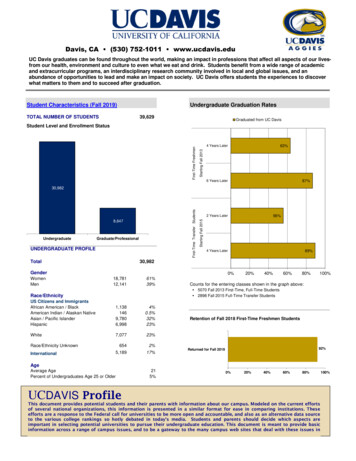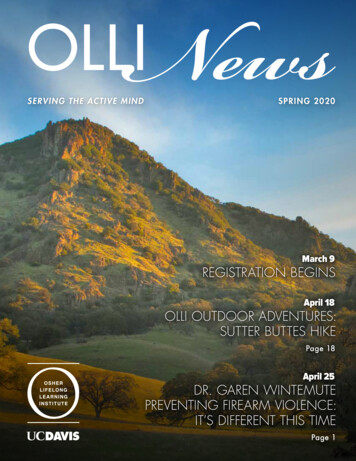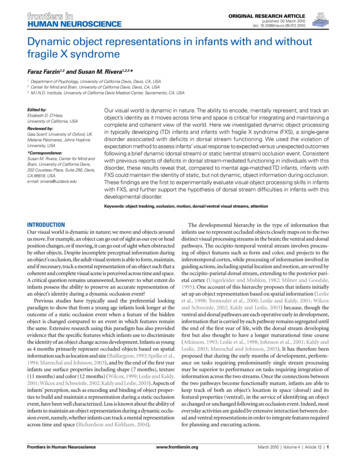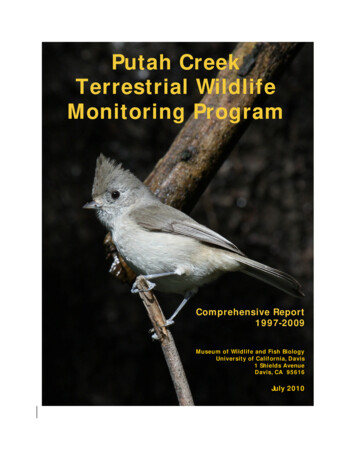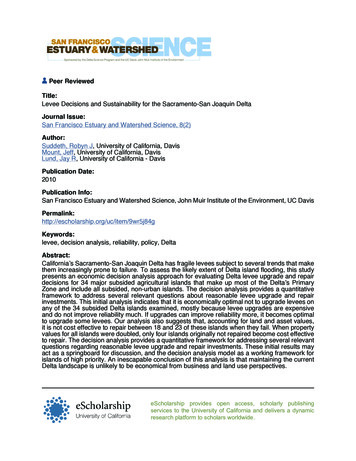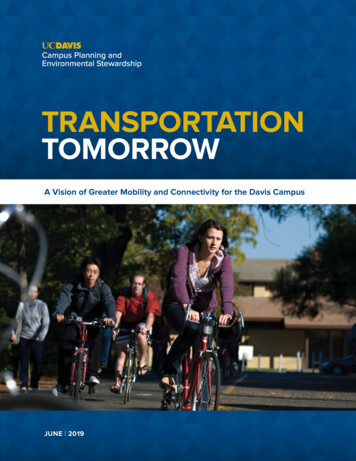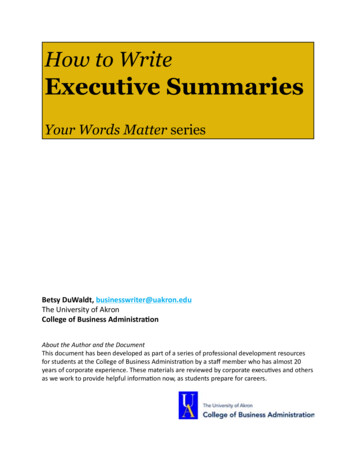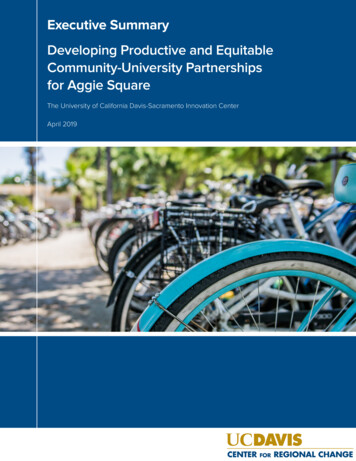
Transcription
Executive SummaryDeveloping Productive and EquitableCommunity-University Partnershipsfor Aggie SquareThe University of California Davis-Sacramento Innovation CenterApril 2019
introductionAggie Square is a joint effort of the University of California, Davis (UC Davis), the City ofSacramento, and multiple other partners. Launched in 2018, Aggie Square will provide arange of co-location spaces for the university, business partners, and local neighborhoodorganizations to collaborate on new economic and community-development enterpriseson and around the UC Davis Health campus in Sacramento. Aggie Square will enhanceUC Davis’ existing urban campus as a place where faculty, students, staff, business, andcommunity organizations can teach and learn together.Aggie Square’s goals reflect UC Davis’ historic mission as a land-grant institution. Theyalso clearly align with the priorities and efforts currently being undertaken by the Cityand County of Sacramento, as well as the city’s business and nonprofit sectors. These canbe summarized in five key development themes:1.2.3.4.5.Inclusive Economic DevelopmentWorkforce Development and EducationHousing Affordability and SupplyCommunity HealthPublic Space and MobilityAggie Square is the product of a rich and ongoing dialogue between the university, cityand community. Still, in embarking on this project, UC Davis recognizes its own specialrole and responsibilities within it. The university’s hybrid role as an academic institution,medical service provider, and major employer makes it a uniquely influential catalyst forcommunity development. In launching this project, the university will be called uponto ensure that Aggie Square will contribute to sustaining neighborhood quality of life forSacramento residents who work and live near the project, as well as the public, privateand nonprofit organizations that serve them.This is especially important in light of community concerns about Aggie Square’swider community impact. These concerns are related to the project’s role in potentiallyexacerbating urban gentrification and displacement, and the need to ensure that residentsof nearby neighborhoods be granted equitable access to the jobs and entrepreneurshipopportunities generated by this initiative.This report is intended to illuminate and address these concerns. It offers insights,lessons and context drawn from both local and national experiences that may help UCDavis and its Aggie Square partners work collaboratively toward a more equitable andsustainable form of local community development. Guided by the shared values listedabove, the report seeks to tackle four principal questions, organized in four separatesections, as follows:e x ec uti v e su m m a ry de v e lopi n g produc ti v e a n d equ ita b le un i v e r s it y- com m un it y pa r tn e r s h ip s f or agg ie s qua re 1
i.which existing uc davis efforts can informaggie square?This section offers a compilation of some existing community-universitypartnerships already established by UC Davis administration, faculty, andstaff, showcasing the university’s substantial record of and commitment tothoughtful community engagement.ii.what local challenges can aggie square address?iii.what local opportunites can aggie square support?iv.which community partnership models can supportaggie square’s goals?This section provides an overview of the local community context asidentified by members of the Aggie Square university and city leadership,residents and other stakeholders.This section offers a review of relevant local planning efforts that articulatecommunity needs, interests, and visions.This section offers a scan of other community-university partnership modelsfrom around the country, suggesting promising practices that may beadaptable for Aggie Square.The report is based on data from several sources. These include demographic data fromthe Center for Regional Change’s (CRC) Regional Opportunity Index, as well as othersources; prior community plans for the neighborhoods near Aggie Square; a nationalscan of promising community-university partnership models; and a survey completedof UC Davis faculty, staff, and administrators working in the neighborhoods adjacent tothe Aggie Square site. The report also reflects feedback received from the CRC’s RegionalAdvisory Committee made up of leaders in the nonprofit, government, business, andphilanthropic sectors, and members of the Aggie Square Community EngagementAdvisory Committee.Here, we provide a summary of each of the report’s four sections. Each is organizedaccording to the five key development themes outlined above.e x ec uti v e su m m a ry de v e lopi n g produc ti v e a n d equ ita b le un i v e r s it y- com m un it y pa r tn e r s h ip s f or agg ie s qua re 2
i.which existing uc davis effortscan inform aggie square?UC Davis has served as an active partner in the Sacramento region for many years, supporting ongoingoutreach programs, investing resources in the community, and pursuing public scholarship. Theseefforts have been initiated by both the Davis and Sacramento campuses, and include faculty-led projects,administration-led programs, and funding for local community partners. Most, if not all, of these effortsalready address the key development themes of Aggie Square.1. Inclusive Economic DevelopmentSome examples of existing UC Davisinitiatives include a study for therevitalization of the Broadway corridor,and the development of a strategy forthe unincorporated neighborhoods ofSouth Sacramento, which are outside cityboundaries.2. Workforce Development andEducationUC Davis has already launched programsin this domain, including Early AcademicOutreach Programs, collaborative researchon supporting school attendance, a rangeof STEM and educational enrichmentprograms, and health workforcedevelopment initiatives.3. Housing Affordability and SupplyUC Davis has already embarked on a studyabout how to increase public support forii.housing affordability and supply, and howto strengthen UC Davis collaboration withthe City of Sacramento on several housingprograms.4. Community HealthUC Davis can point to several projectsthat provide support for farmers’ marketsand community gardens, investigate thehealth and safety of home gardening, andpromote a new kitchen food incubatorprogram. There are also a number ofenvironmental justice studies that focus onthe Sacramento area.5. Public Space and MobilityUC Davis has launched several studies oftransportation planning in the Sacramentoarea, including some that investigatethe health implications of using activetransportation (i.e., walking and biking).what local challenges can aggie square address?Here, we focus on the neighborhoods to the west and south of the UC Davis Health campus, includingOak Park, and parts of South Sacramento such as Avondale, Glen Elder, Fruitridge, and Lemon Hill.Based on a number of criteria described below, these neighborhoods are considered disadvantagedcommunities in need of special attention. This section reviews these neighborhoods’ principal strengthsand needs, in light of Aggie Square’s five key development themes.e x ec uti v e su m m a ry de v e lopi n g produc ti v e a n d equ ita b le un i v e r s it y- com m un it y pa r tn e r s h ip s f or agg ie s qua re 3
1. Inclusive Economic DevelopmentThe overall economic profile of theseneighborhoods is strong, primarily due totheir proximity to the employment centersof UC Davis Health, and downtown andMidtown Sacramento. However, manyresidents do not benefit from theseeconomic opportunities: unemploymentand poverty levels remain high comparedto those in the region and state as a whole.2. Workforce Development andEducationA strong pathway to lifelong learning iscritical to promote the long-term economichealth and well-being of local residents.Educational opportunities in the focusneighborhoods are often lacking. There isa need for comprehensive enhancement,from pre-K through college, and beyond.3. Housing Affordability and SupplyThe Sacramento region is experiencinga major crisis in housing affordabilityand supply, with rents climbing fasterthan those of nearly any other city in thecountry. The neighborhoods around AggieSquare similarly face rising rents andhousing costs, with high levels of housinginsecurity and a strong likelihood ofdisplacement.4. Community HealthHealthy residents are the foundation ofhealthy neighborhoods and a healthyeconomy. The neighborhoods surroundingAggie Square face a number of healthchallenges, but also have some importantassets, including the presence of UC DavisHealth and community clinics.5. Public Space and MobilityThese neighborhoods enjoy valuablepublic space resources that provide parkaccess to area residents. However, theseresources are not evenly spread throughoutthe neighborhoods, making sites forlocal gatherings and events limited forsome. Another significant problem lies inresidents’ uneven access to transit, andhence to educational resources, jobs, andsocial services, especially for lowerincome, transit-dependent residents.iii. what local opportunites can aggie square support?This section reviews several local plans and proposals that represent the needs, visions, and values ofhundreds of residents in the neighborhoods surrounding Aggie Square, as well as those in outlyingareas in South Sacramento. Understanding these initiatives can help Aggie Square leaders and plannersguide the project’s development in ways that affirm and support residents’ expressed goals for theirneighborhoods, respecting hard-earned local knowledge, and supporting existing investments in localcommunity development.e x ec uti v e su m m a ry de v e lopi n g produc ti v e a n d equ ita b le un i v e r s it y- com m un it y pa r tn e r s h ip s f or agg ie s qua re 4
However, it is not enough to incorporate these design elements into Aggie Square-associateddevelopment. Instead, to gain the greatest value from these plans, the Aggie Square partnership shouldwork with neighborhood residents, in a way that allows them to have a voice in the future of theircommunities. This will enable all parties to engage in a thoughtful and participatory assessment of howwell existing plans reflect and support current community interests and needs.1. Inclusive Economic DevelopmentAggie Square’s approach can prioritizeindustry partners who: supportlocal workforce development andentrepreneurship; support thedevelopment of creative institutions suchas co-ops; contribute to local infrastructureand workforce housing; and pay livingwages.the focus neighborhoods. This will helpminimize the displacement of existingresidents, and address housing need foremployees, students, and faculty.4. Community HealthThe university can continue to expandits primary care services to serve nearbyresidents through neighborhood clinicsand other means. Aggie Square could2. Workforce Development andalso collaborate with local nonprofitsEducationand public agencies to establish a serviceAggie Square can contribute to a lifelongdelivery hub that provides support for locallearning continuum by supporting effortschildren and families. Aggie Square couldlike the Oak Park Promise Neighborhoodsupport local food systems by: providingPlan, which proposed a holistic strategyspaces for a farm stand/farmers’ market;that includes educational, health, economic offering support for a cottage-industrydevelopment, and workforce development food kitchen; setting up food educationelements.spaces and urban gardens; and drawing onthe community health expertise of local3. Housing Affordability and Supplyresidents.UC Davis could partner with city, county,and other entities to identify properties5. Public Space and Mobilitysuitable for development to boost housingThe design of Aggie Square can createaffordability and supply. For example,visually welcoming multi-purpose publicAggie Square’s development can investspaces that make the project a gatheringdirectly in development projects, andplace for residents, faculty, staff, andidentify other creative avenues for doingstudents. Transportation planning aroundso, such as housing co-ops, deed-restricted Aggie Square can also improve mobility,affordable housing, and community landconnectivity, circulation, access, and activetrusts. Aggie Square partners can alsotransportation to/from/around Aggiepromote public policies that encourageSquare for pedestrians and bicyclists, whilethe development of affordable housing inenhancing neighborhood vitality.e x ec uti v e su m m a ry de v e lopi n g produc ti v e a n d equ ita b le un i v e r s it y- com m un it y pa r tn e r s h ip s f or agg ie s qua re 5
iv. which community partnership modelscan support aggie square’s goals?Historically, much of UC Davis’ land-grant mission has focused on rural communities. Aggie Squareinvites the university to explore innovative ways to extend its mission into the urban sector. Onenationally established framework for this kind of work is the anchor institution model. This modelemphasizes long-term, place-based investments that universities can make in metropolitan areas. Twomajor anchor institutions in this model are colleges/universities and hospitals (colloquially referred to as“eds and meds”). As a world-class university with a medical school and medical center, UC Davis has theadvantage of being both.Creating a successful anchor institution partnership calls for a series of steps. UC Davis could undertakethese as follows: Identify an anchor institution modelthat can help Aggie Square’s projectleaders serve as effective facilitators,leaders and conveners. As an anchor institution, UC Daviscan bring its community developmentcapabilities to bear on neighborhoodimprovement, leveraging its roles as areal estate developer, cluster anchor,infrastructure builder, service provider,purchaser, employer, and workforcedeveloper. Develop effective governance andparticipation structures and processesthat provide for a decisive yet inclusiveleadership team that includes localresidents. UC Davis might also considerdeveloping a Community BenefitsAgreement (CBA) to ensure mutualaccountability. The CBA could addresssuch issues as: funding to improvee x ec uti v e su m m a ry housing affordability and supply; theestablishment of local hiring and livingwage standards; and the creation ofneighborhood-serving facilities. Identify collaborative communitydevelopment strategies. The AggieSquare leadership could engage witha range of partners in order to addressmultiple, interconnecting aspects ofcommunity health and well-being. Evaluate progress on Aggie Square’simplementation, to promote activelearning and continuous improvement.From the start, Aggie Squarepartners could work collectivelyand meet regularly to measure andreflect on their progress, deepeningand continually updating theirunderstanding of effective and positivecommunity change.de v e lopi n g produc ti v e a n d equ ita b le un i v e r s it y- com m un it y pa r tn e r s h ip s f or agg ie s qua re 6
v.recommendationsTo conclude, this report makes five principal recommendations to the Aggie Square partners. Thesederive from the information and analysis provided in the report’s four main sections, and are intended toboost the project’s success, reach, equity, and sustainability. These are:Sustain a Participatory ProcessBuild on the partnerships that began withthe launch of the Aggie Square planningtrajectory. Include leaders in electedoffice, as well as those from the business,nonprofit, and civic sectors. Make specialefforts to engage with leaders and membersof grassroots organizations, and residentsof the focus neighborhoods, all of whomhave a significant stake in the project’soutcomes, and who are often excludedfrom similar planning efforts.Center on EquityAdopt a social equity approach that paysclose attention to how the benefits andcosts of the project’s development aredistributed. Address key communityconcerns related to Aggie Square’sdevelopment, such as the risk ofgentrification and displacement, and thepotential lack of access to jobs and othereconomic opportunities that communityresidents may encounter.Engage Local Knowledge and AddressLocal NeedsCarefully review the existing communityplans and visions presented in this reportin consultation with local residents, ande x ec uti v e su m m a ry use them to derive design principles andelements that can be adapted to AggieSquare’s development. Work closelywith the city, county, residents and otherpartners to develop a collaborative plan foraddressing a range of neighborhood needsand opportunities.Build on Campus ExpertiseBenefit from and support existingcommunity engagement activities andlong-standing relationships by campusadministration, faculty and staff.Collaborate with campus programs andinitiatives that engage undergraduateand graduate students in experientialand global learning, and tap into studentnetworks, skills, cultural knowledge,energy and insight.Learn from National PromisingPracticesDraw upon the models of anchorinstitutions presented in this report, tohelp maximize UC Davis’ role in promotinglong-term and equitable economicdevelopment and community well-being,and consider developing a CommunityBenefits Agreement or similar framework. de v e lopi n g produc ti v e a n d equ ita b le un i v e r s it y- com m un it y pa r tn e r s h ip s f or agg ie s qua re 7
acknowledgementsUC Davis Center for Regional ChangePrimary authors: Carolyn Abrams, Krista Haapanen, Jonathan K. LondonConsultation on report content: Center for Regional Change Regional Advisory CommitteeGraphic design: Sara WattersonAggie SquareBob Segar, Sonja Colbert, David Wescott, Laura Niznik Williams, Mary Mumper,Mabel Salon, Matt DulcichEditorial AssistanceKrystyna von Henneberg, Ph.D., Founder and Principal, Creative Language Works,Davis, CaliforniaThis executive summary and the full report are available /aboutFor more information, please contact the UC Davis Center for Regional Changecrcinfo@ucdavis.edu https://regionalchange.ucdavis.edue x ec uti v e su m m a ry de v e lopi n g produc ti v e a n d equ ita b le un i v e r s it y- com m un it y pa r tn e r s h ip s f or agg ie s qua re 8
The University of California Davis-Sacramento Innovation Center April 2019. executive summary developing productive and equitable university-community partnerships for aggie square 1 introduction Aggie Square is a joint effort of the University of California, Davis (UC Davis), the City of .
